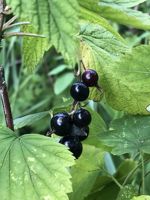Mon-Fri 9am - 5pm Mountain time
Arrowwood vs American Black Currant
Viburnum dentatum
Ribes americanum
NOT AVAILABLE THIS SEASON - MIGHT RETURN
CUSTOM GROW
Arrowwood is a cold hardy, reliable, and vigorous shrub that can easily grow on difficult sites. Featuring an upright, rounded, and multi-stemmed form, this shrub produces creamy white flowers against a backdrop of deep green, serrated foliage.
The flowers give way to dark, blue berries that will attract wildlife to your yard. Depending on the plant, Arrowwood's striking fall color can range from yellow, red to reddish-purple.
Many use Arrowwood for naturalization or mass planting projects but, more commonly, you'll see this simple yet elegant shrub as a shrub border or planted on its own.
American Black Currant is a native deciduous shrub known for its clusters of small black berries that ripen in mid-to-late summer. The berries are edible and have long been used for fresh eating, preserves, and baking. They provide food for birds and mammals, and their fragrant spring flowers attract bees and other pollinators.
American Black Currant’s foliage serves as a host plant for butterfly species such as the Green Comma and Gray Comma, and its dense branching offers cover for wildlife. The shrub has traditionally been planted in shelterbelts, riparian buffers, and restoration projects.

